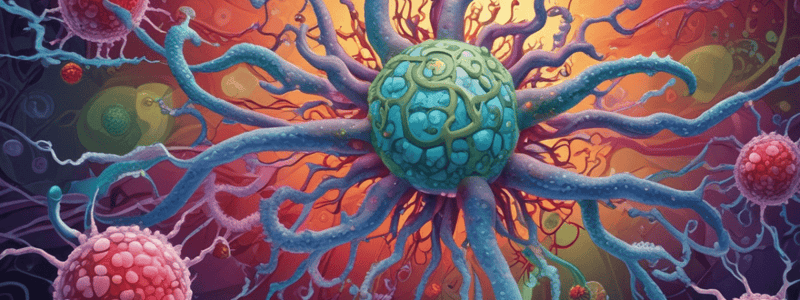Podcast
Questions and Answers
What is the characteristic of the DNA of HSV1 and HSV2?
What is the characteristic of the DNA of HSV1 and HSV2?
- Single-stranded and circular
- Double-stranded and linear (correct)
- Single-stranded and linear
- Triple-stranded and spiral
Where does HSV1 primarily replicate?
Where does HSV1 primarily replicate?
- In the endoplasmic reticulum
- In the mitochondria
- In the cytoplasm
- In the nucleus (correct)
What is the characteristic appearance of Cowdry bodies in HSV1 and HSV2 infections?
What is the characteristic appearance of Cowdry bodies in HSV1 and HSV2 infections?
- Target-like structures (correct)
- Dot-like structures
- Ring-like structures
- Thread-like structures
What is the primary mode of transmission of HSV1 and HSV2?
What is the primary mode of transmission of HSV1 and HSV2?
What is the common complication of HSV1 infection in the eye?
What is the common complication of HSV1 infection in the eye?
What is the characteristic of herpes labialis caused by HSV1?
What is the characteristic of herpes labialis caused by HSV1?
What is the site of latency for HSV1?
What is the site of latency for HSV1?
What is the characteristic of Tzanck smear in HSV1 and HSV2 infections?
What is the characteristic of Tzanck smear in HSV1 and HSV2 infections?
What is the complication of HSV2 infection in the central nervous system?
What is the complication of HSV2 infection in the central nervous system?
What is the characteristic of herpes whitlow caused by HSV1?
What is the characteristic of herpes whitlow caused by HSV1?
What is the primary site of infection for HSV1?
What is the primary site of infection for HSV1?
What is the characteristic appearance of HSV1 ulcers on the lips?
What is the characteristic appearance of HSV1 ulcers on the lips?
What is the common complication of HSV1 infection in the brain?
What is the common complication of HSV1 infection in the brain?
What is the characteristic of HSV2 infection in the genital region?
What is the characteristic of HSV2 infection in the genital region?
Where does HSV2 primarily replicate?
Where does HSV2 primarily replicate?
What is the characteristic of HSV1 latency?
What is the characteristic of HSV1 latency?
What is the characteristic of HSV2 transmission?
What is the characteristic of HSV2 transmission?
What is the characteristic of Erythema multiforme in HSV1 infection?
What is the characteristic of Erythema multiforme in HSV1 infection?
What is the characteristic of Tzanck smear in HSV1 and HSV2 infections?
What is the characteristic of Tzanck smear in HSV1 and HSV2 infections?
What is the characteristic of herpes labialis caused by HSV1?
What is the characteristic of herpes labialis caused by HSV1?
Flashcards are hidden until you start studying
Study Notes
HSV1 and HSV2
- Both are DNA viruses and belong to the Herpesviridae family
- Enveloped viruses with double-stranded linear DNA genomes
- Replicate in the nucleus
Characteristics of HSV Infections
- Transmitted via sexual contact, saliva, and vertically from mother to child
- Two strains: HSV1 and HSV2, with different symptoms and locations
- Can cause latent infections, reacting in trigeminal ganglia (HSV1) and sacral ganglia (HSV2)
HSV1 Infections
- Typically affects the upper half of the body
- Causes inflamed lips, ulcers on lips, and Keratoconjunctivitis
- Can lead to Temporal lobe encephalitis with bizarre behavior
- Most common cause of sporadic encephalitis
- Latent in trigeminal ganglia
- Can cause herpetic whitlow (dew drop on a rose petal appearance)
HSV2 Infections
- Typically affects the genital region
- Causes painful vesicular lesions, inguinal lymphadenopathy, and meningitis
- Latent in sacral ganglia
- Can cause neonatal herpes
Diagnosis and Treatment
- Diagnosed using Tzanc smear to identify multinucleated giant cells
- No cure, but can be managed with acyclovir and valcyclovir to prevent breakouts
- Similar inclusion bodies can be found in cytoplasm in Pox virus infections
HSV1 and HSV2
- Both are DNA viruses and belong to the Herpesviridae family
- Enveloped viruses with double-stranded linear DNA genomes
- Replicate in the nucleus
Characteristics of HSV Infections
- Transmitted via sexual contact, saliva, and vertically from mother to child
- Two strains: HSV1 and HSV2, with different symptoms and locations
- Can cause latent infections, reacting in trigeminal ganglia (HSV1) and sacral ganglia (HSV2)
HSV1 Infections
- Typically affects the upper half of the body
- Causes inflamed lips, ulcers on lips, and Keratoconjunctivitis
- Can lead to Temporal lobe encephalitis with bizarre behavior
- Most common cause of sporadic encephalitis
- Latent in trigeminal ganglia
- Can cause herpetic whitlow (dew drop on a rose petal appearance)
HSV2 Infections
- Typically affects the genital region
- Causes painful vesicular lesions, inguinal lymphadenopathy, and meningitis
- Latent in sacral ganglia
- Can cause neonatal herpes
Diagnosis and Treatment
- Diagnosed using Tzanc smear to identify multinucleated giant cells
- No cure, but can be managed with acyclovir and valcyclovir to prevent breakouts
- Similar inclusion bodies can be found in cytoplasm in Pox virus infections
Studying That Suits You
Use AI to generate personalized quizzes and flashcards to suit your learning preferences.



